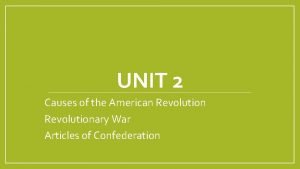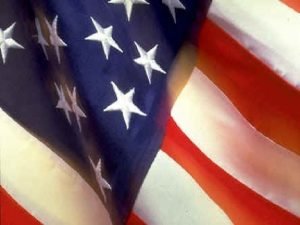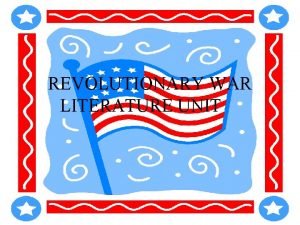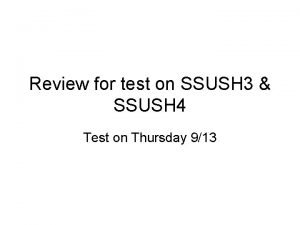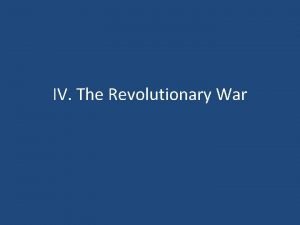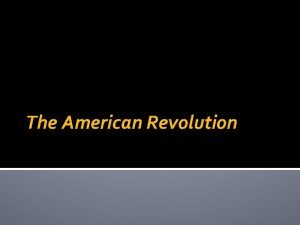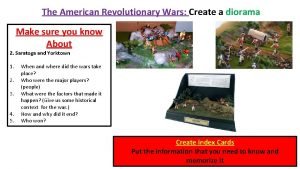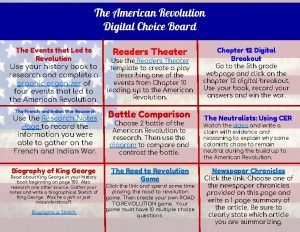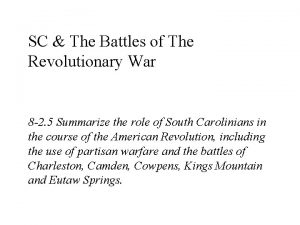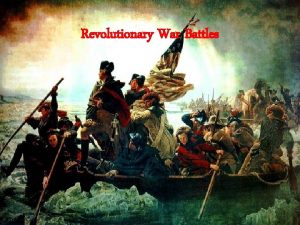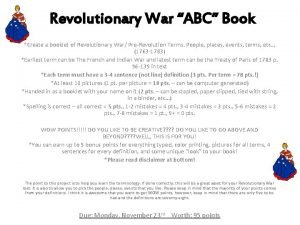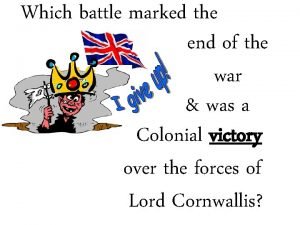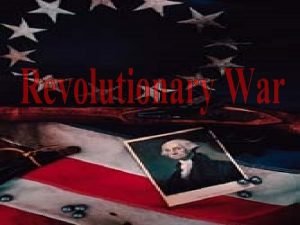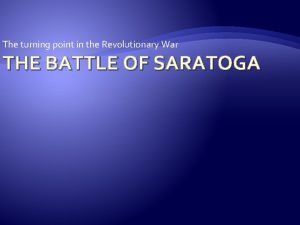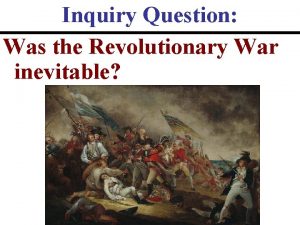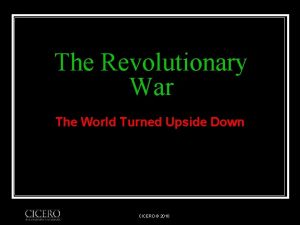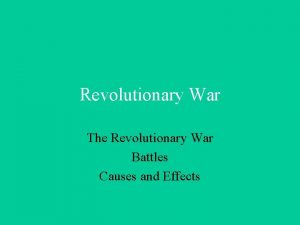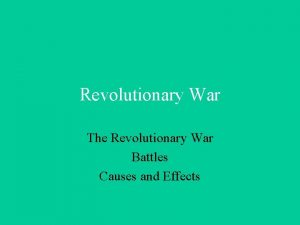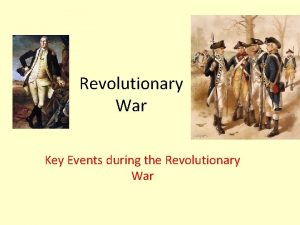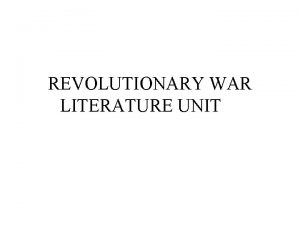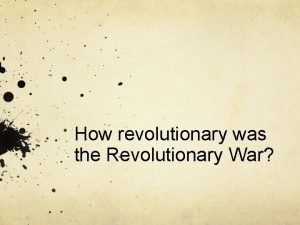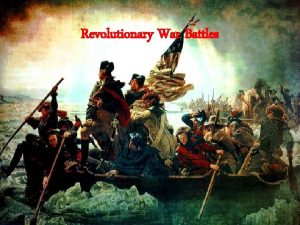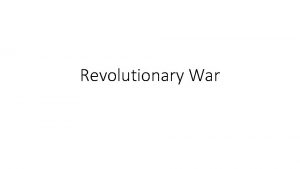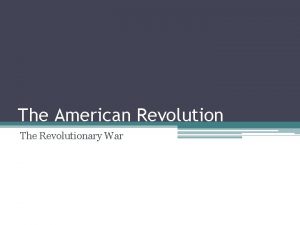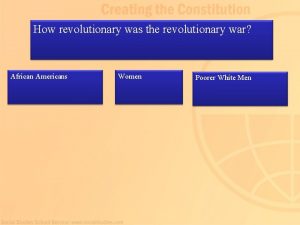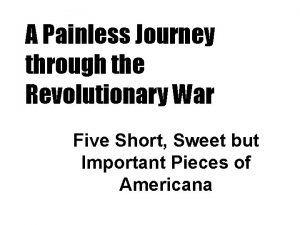Unit Five The Revolutionary War The World Turned


















- Slides: 18

Unit Five: The Revolutionary War “The World Turned Up Side Down”

The War in the South • After the Battle of Monmouth Courthouse Clinton with General Charles Cornwallis sailed from New York to take the city of Savannah as a foothold to the south. • The British easily took Savannah with little resistance in December of 1778. (The Patriots tried to retake it in 1779 but failed) • After the Second Battle of Savannah, Clinton moved to take Charleston, S. C. to take control of the major ports in the south.

Siege of Charlestown • Clinton began his attack on Charlestown in April 1779 and quickly surrounded the city and cut it off from supplies. • The Patriot forces surrendered in May with over 5, 000 troops taken prisoner. • Clinton then sailed back to New York leaving Cornwallis in command.

Southern Campaign • From Charlestown the British moved to subdue the South Carolina back country. • To succeed in this mission Cornwallis used a Calvary Colonel, Banastre Tarleton, to chase and attack the Patriots. (Tarleton due to his tactics became the most hated man in the South) • At the Battle of Waxhaws Tarleton defeated the Patriots then killed or mortally wounded the P. O. Ws. (this became known as Tarleton’s Quarter) • At the Battle of Camden Cornwallis defeated Horatio Gates allowing for the invasion of North Carolina.

Southern Campaign • Command in the South was turned over to Nathanael Greene who began recruiting to defend North Carolina. • Fighting in South Carolina did not stop, but was carried on by militia leader like Francis Marion (swamp fox), Thomas Sumter (carolina gamecock), and Andrew Pickens (wizard owl) who used guerilla style tactics to harass and delay Tory and British Regulars. • Banastre Tarleton was given the specific mission of hunting down and killing Marion, but could never catch him.

Southern Campaign • At the Battle of King’s Mountain (Oct. 1780) a Tory force led by Major Patrick Ferguson tried to advance into North Carolina but were met by a Patriot force led by Colonel Isaac Shelby and were defeated. (to avenge the Waxhaws all prisoners were killed) • In the same month at the Battle of Cowpens a Patriot force led by Daniel Morgan defeated Tarleton costing Cornwallis some of his best soldiers.

Divide and Conquer • Nathaniel Greene decided to fight more of a guerilla style war with the development of strategic retreat. • With strategic retreat the plan was to use a hit and run tactic to wear down the enemy by having to constantly be in chase. • The plan did exactly what it needed to do by wearing down the British soldiers physically and morally by never being able to gain a victory.

Southern Campaign • The next major confrontation was at the Battle of Guilford’s Courthouse where Greene met Cornwallis near Greensboro, N. C. • The British won the field but at a high causality cost, giving the Patriots a huge morale victory. • The Battle also forced Cornwallis into retreat to regroup and resupply his men in Wilmington, N. C then moving to Yorktown, Virginia. • The last major battle of the Southern Campaign was the Battle of Eutaw Springs which ended in an American victory.

Battle of Guilford Courthouse

The Last Campaign • Cornwallis in 1781 moved into Virginia fighting small skirmishes with Lafayette almost capturing Thomas Jefferson, then moved to fortify the city of Yorktown and wait for the British navy. • At the Battle of Yorktown the French Navy led by Comte de Grasse blocked any escape by sea, while a patriot force led by Washington and a French force led by Comte de Rochambeau surrounded the town creating a siege of Yorktown.

Its over • Cornwallis with no escape possible surrendered his army on 19 Oct. 1781. • As Cornwallis and his men were taken as prisoners of war his drummers played the song “The World Turned upside Down”, which in return the Americans played “Yankee Doodle” • Parliament canceled any more attacks and peace negotiations were opened between the “countries”.

Yankee Doodle (Fool) Yankee Doodle went to town A-riding on a pony Stuck a feather in his hat And called it macaroni. Yankee Doodle, keep it up Yankee Doodle dandy Mind the music and the step And with the girls be handy. Father and I went down to camp Along with Captain Gooding And there we saw the men and boys As thick as hasty pudding. Yankee Doodle, keep it up Yankee Doodle dandy Mind the music and the step And with the girls be handy There was Captain Washington Upon a slapping stallion A-giving orders to his men I guess there was a million. Yankee Doodle, keep it up Yankee Doodle dandy Mind the music and the step And with the girls be handy. • The song of Yankee Doodle Dandy developed around the time of the French and Indian war and Revolution to mock the American Militiamen. • The song then was changed to represent the new National feeling during the Revolution.

Peace • Peace negotiations were opened with all combatant nations: Spain, France, Britain, and America. (Benjamin Franklin, John Jay, and John Adams were the delegates) • The Americans opened up with a request for Canada, but were denied. • The negations were finally ended with the signing of the Treaty of Paris 1783 officially ending the Revolutionary War creating These United States of America.

Treaty of Paris 1783 • The Treaty of Paris of 1783 granted: – 1. ) Great Britain recognized America as a nation. – 2. ) Border with Canada set at Mississippi River and Great Lakes. – 3. ) American boundary with Spain at Mississippi River, but Americans could use it and the port of New Orleans for trade. – 4. ) Spain received both West and East Florida. – 5. ) Great Britain had to withdraw all troops and forts. – 6. ) Tories were to be given back property and treated fairly.

Impact of the Revolution • The Revolutionary War created the independent country of These United States of America. • It led to feelings of Patriotism (love and devotion to one’s nation) among citizens. • It also had an effect on Loyalists, Indians, slaves, and women. • It led to conflict within the new nation over how the new government should be, structured, run, and how much power it was to have. • It led to an Age of Revolutions in the world, where colonies and people questioned the idea of inequality and liberty.

Loyalists and Indians • After the war many Loyalists were treated as traitors for their actions during the war. • Many Loyalists fled the states and moved to Canada and England. • The Native Americans for helping the British were treated harshly by the new government. • The encroachment on Indian lands spread quickly causing a constant string of conflicts with the Native Americans.

Notable Women • During the Revolution there were many notable women who fought or participated in the War effort. • Abigail Adams was the wife of John Adams and through her letters constantly aided with decision making. • Martha Washington aided her husband in many occasions and like many women ran the home while he was away. • Mary “Molly Pitcher” Mc. Cauley in the Battle of Monmouth Courthouse fought killing British and working one of the cannons. • Margaret “Dirty Kate” Corbin fought along side of her husband at the Battle of New York. • Deborah Sampson was a free black women who dressed as man and fought in the Continental Army.

Freemen and Slaves • During the War many Free black men and slaves fought in militias and the Continental Army along side white soldiers. • Many were used in auxiliary jobs like cooks, transporters, and diggers. • As the war developed the emancipation (freeing) of slaves became a huge topic. • Some states offered Manumission laws or the voluntary freeing of slaves who fought in the war. • The British and even Washington offered slaves who fought their freedom after the end of the war.
 Causes of the american revolutionary war
Causes of the american revolutionary war Music of the revolutionary war
Music of the revolutionary war Revolutionary war literature
Revolutionary war literature Ssush
Ssush Continental army strengths and weaknesses
Continental army strengths and weaknesses Lemuel hayes revolutionary war
Lemuel hayes revolutionary war Boston tea party diorama
Boston tea party diorama American revolution digital breakout answers
American revolution digital breakout answers Revolutionary war blockade
Revolutionary war blockade Map of the battle of fort ticonderoga
Map of the battle of fort ticonderoga Abc revolutionary war
Abc revolutionary war Revolutionary war
Revolutionary war Revolutionary war british strengths and weaknesses
Revolutionary war british strengths and weaknesses Revolutionary war interactive notebook
Revolutionary war interactive notebook Which battle
Which battle British strengths during the revolutionary war
British strengths during the revolutionary war Turning point of the revolutionary war
Turning point of the revolutionary war Inquiry answer 12
Inquiry answer 12 Revolutionary
Revolutionary
